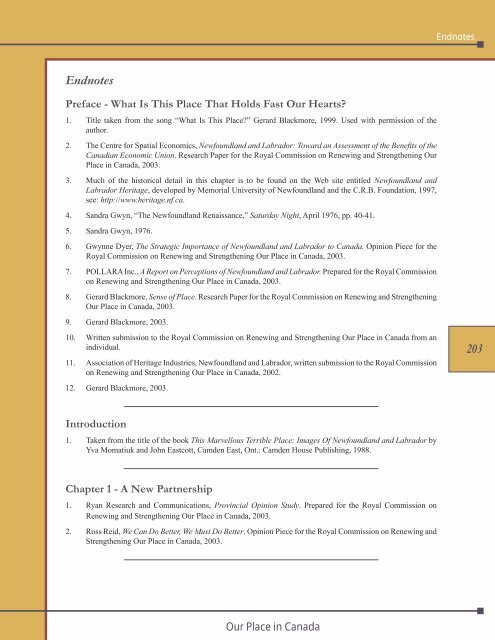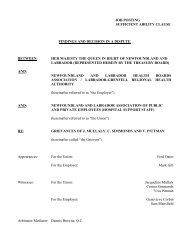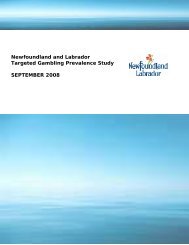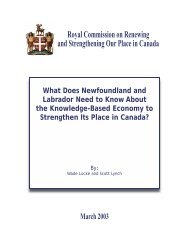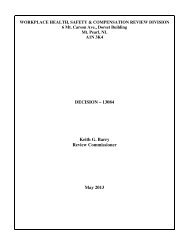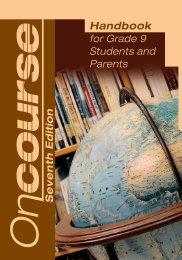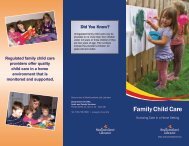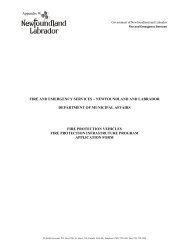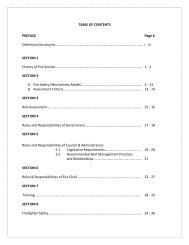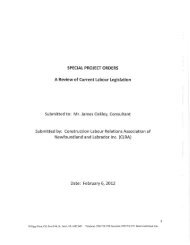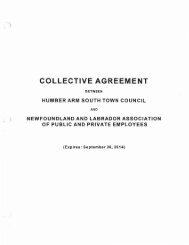Section 7 - Government of Newfoundland and Labrador
Section 7 - Government of Newfoundland and Labrador
Section 7 - Government of Newfoundland and Labrador
Create successful ePaper yourself
Turn your PDF publications into a flip-book with our unique Google optimized e-Paper software.
Endnotes<br />
Endnotes<br />
Preface - What Is This Place That Holds Fast Our Hearts?<br />
1. Title taken from the song “What Is This Place?” Gerard Blackmore, 1999. Used with permission <strong>of</strong> the<br />
author.<br />
2. The Centre for Spatial Economics, <strong>Newfoundl<strong>and</strong></strong> <strong>and</strong> <strong>Labrador</strong>: Toward an Assessment <strong>of</strong> the Benefi ts <strong>of</strong> the<br />
Canadian Economic Union. Research Paper for the Royal Commission on Renewing <strong>and</strong> Strengthening Our<br />
Place in Canada, 2003.<br />
3. Much <strong>of</strong> the historical detail in this chapter is to be found on the Web site entitled <strong>Newfoundl<strong>and</strong></strong> <strong>and</strong><br />
<strong>Labrador</strong> Heritage, developed by Memorial University <strong>of</strong> <strong>Newfoundl<strong>and</strong></strong> <strong>and</strong> the C.R.B. Foundation, 1997,<br />
see: http://www.heritage.nf.ca.<br />
4. S<strong>and</strong>ra Gwyn, “The <strong>Newfoundl<strong>and</strong></strong> Renaissance,” Saturday Night, April 1976, pp. 40-41.<br />
5. S<strong>and</strong>ra Gwyn, 1976.<br />
6. Gwynne Dyer, The Strategic Importance <strong>of</strong> <strong>Newfoundl<strong>and</strong></strong> <strong>and</strong> <strong>Labrador</strong> to Canada. Opinion Piece for the<br />
Royal Commission on Renewing <strong>and</strong> Strengthening Our Place in Canada, 2003.<br />
7. POLLARA Inc., A Report on Perceptions <strong>of</strong> <strong>Newfoundl<strong>and</strong></strong> <strong>and</strong> <strong>Labrador</strong>. Prepared for the Royal Commission<br />
on Renewing <strong>and</strong> Strengthening Our Place in Canada, 2003.<br />
8. Gerard Blackmore, Sense <strong>of</strong> Place. Research Paper for the Royal Commission on Renewing <strong>and</strong> Strengthening<br />
Our Place in Canada, 2003.<br />
9. Gerard Blackmore, 2003.<br />
10. Written submission to the Royal Commission on Renewing <strong>and</strong> Strengthening Our Place in Canada from an<br />
individual.<br />
11. Association <strong>of</strong> Heritage Industries, <strong>Newfoundl<strong>and</strong></strong> <strong>and</strong> <strong>Labrador</strong>, written submission to the Royal Commission<br />
on Renewing <strong>and</strong> Strengthening Our Place in Canada, 2002.<br />
12. Gerard Blackmore, 2003.<br />
203<br />
Introduction<br />
1. Taken from the title <strong>of</strong> the book This Marvellous Terrible Place: Images Of <strong>Newfoundl<strong>and</strong></strong> <strong>and</strong> <strong>Labrador</strong> by<br />
Yva Momatiuk <strong>and</strong> John Eastcott, Camden East, Ont.: Camden House Publishing, 1988.<br />
Chapter 1 - A New Partnership<br />
1. Ryan Research <strong>and</strong> Communications, Provincial Opinion Study. Prepared for the Royal Commission on<br />
Renewing <strong>and</strong> Strengthening Our Place in Canada, 2003.<br />
2. Ross Reid, We Can Do Better, We Must Do Better. Opinion Piece for the Royal Commission on Renewing <strong>and</strong><br />
Strengthening Our Place in Canada, 2003.<br />
Our Place in Canada
Endnotes<br />
204<br />
Chapter 2 - Expectations As We Joined Canada<br />
1. Melvin Baker, Falling into the Canadian Lap: The Confederation <strong>of</strong> <strong>Newfoundl<strong>and</strong></strong> <strong>and</strong> Canada, 1945-1949.<br />
Research Paper for the Royal Commission on Renewing <strong>and</strong> Strengthening Our Place in Canada, 2003.<br />
2. See also: Peter Neary, <strong>Newfoundl<strong>and</strong></strong> in the North Atlantic World, 1929-1949. Montreal & Kingston: McGill-<br />
Queen’s University Press, 1988; <strong>and</strong> John FitzGerald, ed., <strong>Newfoundl<strong>and</strong></strong> at the Crossroads: Documents on<br />
Confederation with Canada. St. John’s: Terra Nova Publishing, 2002.<br />
3. Both <strong>Newfoundl<strong>and</strong></strong> <strong>and</strong> Canada were described as Dominions in the Balfour Declaration <strong>of</strong> 1926 <strong>and</strong> in the<br />
Statute <strong>of</strong> Westminister <strong>of</strong> 1931.<br />
4. James Hiller, “Confederation Defeated: The <strong>Newfoundl<strong>and</strong></strong> Election <strong>of</strong> 1869,” in Hiller <strong>and</strong> Neary, eds.,<br />
<strong>Newfoundl<strong>and</strong></strong> in the Nineteenth <strong>and</strong> Twentieth Centuries: Essays in Interpretation. Toronto: University <strong>of</strong><br />
Toronto Press, 1980, pp. 67-94, referenced in Melvin Baker, Falling into the Canadian Lap, 2003. Talks<br />
between Canada <strong>and</strong> <strong>Newfoundl<strong>and</strong></strong> regarding Confederation failed in 1895. See: Melvin Baker, Chronology<br />
<strong>of</strong> Key Events. Research Paper for the Royal Commission on Renewing <strong>and</strong> Strengthening Our Place in<br />
Canada, 2003.<br />
5. Melvin Baker, Falling into the Canadian Lap, 2003.<br />
6. Peter Neary, 1988, pp. 8-15; S.J.R. Noel, Politics in <strong>Newfoundl<strong>and</strong></strong>. Toronto: University <strong>of</strong> Toronto Press,<br />
1971, pp. 149-214, discussed in Melvin Baker, Falling into the Canadian Lap, 2003.<br />
7. Melvin Baker, Falling into the Canadian Lap, 2003.<br />
8. <strong>Newfoundl<strong>and</strong></strong> Act, 1933 (UK).<br />
9. James Hiller, Confederation: Deciding <strong>Newfoundl<strong>and</strong></strong>’s Future, 1934 to 1949. St. John’s: The <strong>Newfoundl<strong>and</strong></strong><br />
Historical Society, 1998, p. 8.<br />
10. The election <strong>of</strong> a <strong>Labrador</strong>ian to the National Convention marked the first time <strong>Labrador</strong> had its own<br />
representative in a local elected body.<br />
11. Paul Bridle, ed., Documents <strong>and</strong> Relations Between Canada <strong>and</strong> <strong>Newfoundl<strong>and</strong></strong>, Vol. 2, 1940-1949. Ottawa:<br />
Supply <strong>and</strong> Services Canada, 1984, p. 198.<br />
12. Melvin Baker, Falling into the Canadian Lap, 2003.<br />
13. Peter Neary, 1988, pp. 311-312.<br />
14. Peter Neary, 1988, p. 317.<br />
15. A summary <strong>of</strong> this cost-benefit analysis is provided in Melvin Baker, Falling into the Canadian Lap, 2003.<br />
16. Stephen May, The Terms <strong>of</strong> Union: An Analysis <strong>of</strong> Their Current Relevance. Research Paper for the Royal<br />
Commission on Renewing <strong>and</strong> Strengthening Our Place in Canada, 2003. A discussion <strong>of</strong> the dynamic <strong>of</strong><br />
these negotiations is also provided in Melvin Baker, Falling into the Canadian Lap, 2003.<br />
17. Term 2, as amended, says: “The Province <strong>of</strong> <strong>Newfoundl<strong>and</strong></strong> <strong>and</strong> <strong>Labrador</strong> shall comprise the same territory<br />
as at the date <strong>of</strong> Union, that is to say, the isl<strong>and</strong> <strong>of</strong> <strong>Newfoundl<strong>and</strong></strong> <strong>and</strong> the isl<strong>and</strong>s adjacent thereto, the Coast<br />
<strong>of</strong> <strong>Labrador</strong> as delimited in the report delivered by the Judicial Committee <strong>of</strong> His Majesty’s Privy Council on<br />
the first day <strong>of</strong> March, 1927, <strong>and</strong> approved by His Majesty in His Privy Council on the twenty-second day <strong>of</strong><br />
March, 1927, <strong>and</strong> the isl<strong>and</strong>s adjacent to the said Coast <strong>of</strong> <strong>Labrador</strong>.”<br />
18. Term 32(1) says: “Canada will maintain in accordance with the traffic <strong>of</strong>fering a freight <strong>and</strong> passenger<br />
steamship service between North Sydney <strong>and</strong> Port aux Basques, which, on completion <strong>of</strong> a motor highway<br />
between Corner Brook <strong>and</strong> Port aux Basques, will include suitable provision for the carriage <strong>of</strong> motor<br />
vehicles.”<br />
Our Place in Canada
Endnotes<br />
19. Terms 46, as amended, says: “(1) Oleomargarine or margarine may be manufactured or sold in the Province<br />
<strong>of</strong> <strong>Newfoundl<strong>and</strong></strong> <strong>and</strong> <strong>Labrador</strong> after the date <strong>of</strong> the Union <strong>and</strong> the Parliament <strong>of</strong> Canada shall not prohibit or<br />
restrict such manufacture or sale except at the request <strong>of</strong> the Legislature <strong>of</strong> the Province <strong>of</strong> <strong>Newfoundl<strong>and</strong></strong> <strong>and</strong><br />
<strong>Labrador</strong>, but nothing in this Term shall affect the power <strong>of</strong> the Parliament <strong>of</strong> Canada to require compliance<br />
with st<strong>and</strong>ards <strong>of</strong> quality applicable throughout Canada. (2) Unless the Parliament <strong>of</strong> Canada otherwise<br />
provides or unless the sale <strong>and</strong> manufacture in, <strong>and</strong> the interprovincial movement between, all provinces <strong>of</strong><br />
Canada other than <strong>Newfoundl<strong>and</strong></strong> <strong>and</strong> <strong>Labrador</strong>, <strong>of</strong> oleomargarine <strong>and</strong> margarine, is lawful under the laws<br />
<strong>of</strong> Canada, oleomargarine or margarine shall not be sent, shipped, brought, or carried from the Province <strong>of</strong><br />
<strong>Newfoundl<strong>and</strong></strong> <strong>and</strong> <strong>Labrador</strong> into any other province <strong>of</strong> Canada.”<br />
20. For example, Prince Edward Isl<strong>and</strong>’s Terms <strong>of</strong> Union obligated the <strong>Government</strong> <strong>of</strong> Canada to operate a ferry<br />
service between P.E.I. <strong>and</strong> the mainl<strong>and</strong>.<br />
21. J.G. Channing, The Effects <strong>of</strong> Transition to Confederation on Public Administration in <strong>Newfoundl<strong>and</strong></strong>.<br />
Toronto: The Institute <strong>of</strong> Public Administration <strong>of</strong> Canada, 1982, p. 41.<br />
22. The grants assured by Term 28 were transitional for a period <strong>of</strong> 12 years.<br />
Chapter 3 - Experiences Within Canada<br />
1. Statistics Canada, Labour Force Survey, May 2003.<br />
2. The number <strong>of</strong> people employed in the province did increase somewhat, rising from 211.3 thous<strong>and</strong> in<br />
2001 to 213.9 thous<strong>and</strong> in 2002. However, that increase in employment is only a little over 1 per cent. The<br />
unemployment rate increased because that modest employment growth was smaller than the increase in the<br />
size <strong>of</strong> the labour force.<br />
3. <strong>Government</strong> <strong>of</strong> <strong>Newfoundl<strong>and</strong></strong> <strong>and</strong> <strong>Labrador</strong>, Strategic Social Plan Office, From the Ground Up. St. John’s:<br />
<strong>Government</strong> <strong>of</strong> <strong>Newfoundl<strong>and</strong></strong> <strong>and</strong> <strong>Labrador</strong>, 2003.<br />
4. Lawrence Felt, Small, Isolated <strong>and</strong> Successful: Lessons from Small, Isolated Societies <strong>of</strong> the North Atlantic.<br />
Research Paper for the Royal Commission on Renewing <strong>and</strong> Strengthening Our Place in Canada, 2003.<br />
5. Miriam Wright, <strong>Newfoundl<strong>and</strong></strong> <strong>and</strong> <strong>Labrador</strong> History in Canada, 1949-72. Research Paper for the Royal<br />
Commission on Renewing <strong>and</strong> Strengthening Our Place in Canada, 2003.<br />
6. Jerry Bannister, The Politics <strong>of</strong> Cultural Memory: Themes in the History <strong>of</strong> <strong>Newfoundl<strong>and</strong></strong> <strong>and</strong> <strong>Labrador</strong> in<br />
Canada, 1972-2003. Research Paper for the Royal Commission on Renewing <strong>and</strong> Strengthening Our Place in<br />
Canada, 2003.<br />
7. For the most recent data, see the results reported by Ryan Research <strong>and</strong> Communications, Provincial Opinion<br />
Survey. Prepared for the Royal Commission on Renewing <strong>and</strong> Strengthening Our Place in Canada, 2003.<br />
8. The following is based on the discussion in Peter Neary, <strong>Newfoundl<strong>and</strong></strong> in the North Atlantic World 1929-<br />
1949. Montreal & Kingston: McGill-Queen’s University Press, 1988, Chapter 12. See also Roger Gibbins,<br />
Assessing <strong>Newfoundl<strong>and</strong></strong> <strong>and</strong> <strong>Labrador</strong>’s Position on Canada’s Evolving Federalism L<strong>and</strong>scape. Research<br />
Paper for the Royal Commission on Renewing <strong>and</strong> Strengthening Our Place in Canada, 2003.<br />
9. See: R<strong>and</strong> Dyck, Provincial Politics in Canada, 3 rd edition. Scarborough: Prentice-Hall, 1996, p. 646.<br />
10. Christopher Dunn, Federal Representation <strong>of</strong> the People <strong>and</strong> <strong>Government</strong> <strong>of</strong> <strong>Newfoundl<strong>and</strong></strong> <strong>and</strong> <strong>Labrador</strong>.<br />
Research Paper for the Royal Commission on Renewing <strong>and</strong> Strengthening Our Place in Canada, 2003.<br />
11. For the annual figures from 1981 to 2000, see Figure 4 in The Centre for Spatial Economics, <strong>Newfoundl<strong>and</strong></strong><br />
<strong>and</strong> <strong>Labrador</strong>: Toward an Assessment <strong>of</strong> the Benefi ts <strong>of</strong> the Canadian Economic Union. Research Paper for<br />
the Royal Commission on Renewing <strong>and</strong> Strengthening Our Place in Canada, 2003.<br />
12. The Centre for Spatial Economics, 2003.<br />
205<br />
Our Place in Canada
Endnotes<br />
13. The Commission is aware that there is a considerable range for this estimate, <strong>and</strong> the paper by The Centre<br />
for Spatial Economics does incorporate lower-end <strong>and</strong> higher-end estimates. Nevertheless, this estimate<br />
is reasonable, <strong>and</strong> it is consistent with the findings <strong>of</strong> other independent studies that also conclude that<br />
the windfall resource revenues are several hundred millions <strong>of</strong> dollars annually. Jean-Thomas Bernard<br />
(Hydroelectricity, Royalties <strong>and</strong> Industrial Competitiveness. Discussion Paper No.93-04, School <strong>of</strong> Policy<br />
Studies: Queen’s University, 1993), reports on the results <strong>of</strong> two such studies; one by Zuker <strong>and</strong> Jenkins<br />
(Blue Gold: HydroElectric Rent in Canada. Ottawa: Economic Council <strong>of</strong> Canada, 1984), <strong>and</strong> the other by<br />
Bernard, Bridges <strong>and</strong> Scott (Our Evaluation <strong>of</strong> Potential Canadian HydroElectric Rents. Resource Paper No.<br />
78, Department <strong>of</strong> Economics, University <strong>of</strong> British Columbia, 1982).<br />
14. Gwynne Dyer, The Strategic Importance <strong>of</strong> <strong>Newfoundl<strong>and</strong></strong> <strong>and</strong> <strong>Labrador</strong> to Canada. Opinion Paper for the<br />
Royal Commission on Renewing <strong>and</strong> Strengthening Our Place in Canada, 2003.<br />
15. See: Peter Leslie <strong>and</strong> Richard Simeon, “The Battle <strong>of</strong> the Balance Sheets,” in Richard Simeon, ed., Must<br />
Canada Fail? Montreal & Kingston: McGill-Queen’s University Press, 1977.<br />
206<br />
Chapter 4 - Population Loss, Out-Migration <strong>and</strong><br />
Rural <strong>Newfoundl<strong>and</strong></strong> <strong>and</strong> <strong>Labrador</strong><br />
1. Economic Council <strong>of</strong> Canada, <strong>Newfoundl<strong>and</strong></strong>: From Dependency to Self-Reliance. Hull, Quebec: Ministry <strong>of</strong><br />
Supply <strong>and</strong> Services Canada, 1980, p. 5. This report points out that in 1942 there was full employment, which<br />
was sustained by a revival <strong>of</strong> export markets after 1945.<br />
2. John N. Cardoulis, in his book entitled A Friendly Invasion II: A Personal Touch (Creative Publishers: St<br />
John’s, 1993, p. 67), places this number at 25,000 women, while Joey Smallwood (The Book <strong>of</strong> <strong>Newfoundl<strong>and</strong></strong>,<br />
Volume IV. <strong>Newfoundl<strong>and</strong></strong> Publishers: St. John’s, 1967, p. 534) places this number much higher, at 31,000 by<br />
the year 1958.<br />
3. Since 1949, only one other province has had a significant decline in population. From 1968 until 1974,<br />
Saskatchewan’s population fell. It also fell again from 1987 to 1991. The proportional declines were in<br />
each case less than <strong>Newfoundl<strong>and</strong></strong> <strong>and</strong> <strong>Labrador</strong>’s. In addition, the declines were reversed after a few years,<br />
whereas this province’s population is projected to decline modestly for the next 15 years (<strong>Government</strong> <strong>of</strong><br />
<strong>Newfoundl<strong>and</strong></strong> <strong>and</strong> <strong>Labrador</strong>, Demographic Change: <strong>Newfoundl<strong>and</strong></strong> <strong>and</strong> <strong>Labrador</strong> Issues <strong>and</strong> Implications.<br />
St. John’s: Economic <strong>and</strong> Statistics Branch, Department <strong>of</strong> Finance, April 2002).<br />
4. Craig Brett, Demographic Trends <strong>and</strong> Implications for Public Policy. Research Paper for the Royal<br />
Commission on Renewing <strong>and</strong> Strengthening Our Place in Canada, 2003. A striking statistic about the loss<br />
<strong>of</strong> our educated young involves those who attend university outside the province. According to Brett (2003),<br />
only 11.5 per cent <strong>of</strong> the 1986 cohort <strong>of</strong> those graduates were residing in <strong>Newfoundl<strong>and</strong></strong> <strong>and</strong> <strong>Labrador</strong> five<br />
years after graduation, <strong>and</strong> the figures for the 1982 <strong>and</strong> 1990 cohorts were not much better at just over 20 per<br />
cent.<br />
5. Leslie Bella, <strong>Newfoundl<strong>and</strong></strong>ers: Home <strong>and</strong> Away. St. John’s: Greetings from <strong>Newfoundl<strong>and</strong></strong> Ltd., 2002, pp.<br />
xiii-xiv.<br />
6. Craig Brett, 2003.<br />
7. <strong>Government</strong> <strong>of</strong> <strong>Newfoundl<strong>and</strong></strong> <strong>and</strong> <strong>Labrador</strong>, Overview <strong>of</strong> Demographic Change. St. John’s: Economics <strong>and</strong><br />
Statistics Branch, Deparment <strong>of</strong> Finance, June 2002.<br />
8. Craig Brett, 2003.<br />
9. Economic Council <strong>of</strong> Canada, 1980, p. 25.<br />
10. Parzival Copes, The Resettlement <strong>of</strong> Fishing Communities in <strong>Newfoundl<strong>and</strong></strong>. Ottawa: Canadian Council on<br />
Rural Development, 1972, cited in Craig Brett, 2003.<br />
Our Place in Canada
Endnotes<br />
11. Economic Council <strong>of</strong> Canada, 1980.<br />
12. Dr. House’s own account <strong>of</strong> the ERC is provided in J.D. House, Against the Tide: Battling for Economic<br />
Renewal in <strong>Newfoundl<strong>and</strong></strong> <strong>and</strong> <strong>Labrador</strong>. Toronto: University <strong>of</strong> Toronto Press, 1999.<br />
13. Raymond Blake, Regional <strong>and</strong> Rural Development Strategies in Canada: the Search for Solutions. Research<br />
Paper for the Royal Commission on Renewing <strong>and</strong> Strengthening Our Place in Canada, 2003.<br />
14. Lawrence Felt, Small, Isolated <strong>and</strong> Successful: Lessons from Small, Isolated Societies <strong>of</strong> the North Atlantic.<br />
Research Paper for the Royal Commission on Renewing <strong>and</strong> Strengthening Our Place in Canada, 2003. Here<br />
Felt stresses that it is crucial to remember that societies are not interchangeable, st<strong>and</strong>ardized creations.<br />
15. For more information on these projects see: Coasts Under Stress: http://www.coastsunderstress.ca; the<br />
Natural Resource Depletion <strong>and</strong> Health Project: http://www.mun.ca/cin/Depletion.html; <strong>and</strong> The Rural<br />
Economy: http://www.swgc.mun.ca/research/faculty-research.html.<br />
Chapter 5 - Social Inclusion In <strong>Newfoundl<strong>and</strong></strong> <strong>and</strong> <strong>Labrador</strong><br />
1. Jane Jenson, Mapping Social Cohesion: The State <strong>of</strong> Canadian Research. Ottawa: Canadian Policy Research,<br />
1998, p. 6.<br />
2. Steve Rosell et al., Changing Maps: Governing in a World <strong>of</strong> Rapid Change. Ottawa: Carlton University<br />
Press, 1995. as quoted in Judith Maxwell, Social Dimensions <strong>of</strong> Economic Growth. Eric John Hansom<br />
Commemorative Conferences, Vol. VII, University <strong>of</strong> Alberta, 1996.<br />
3. Christa Freiler, What Needs to Change? Towards a Vision <strong>of</strong> Social Inclusion for Children, Families <strong>and</strong><br />
Communities – a Draft Paper Concept. Toronto: Laidlaw Foundation, 2001, p. 35.<br />
4. <strong>Government</strong> <strong>of</strong> <strong>Newfoundl<strong>and</strong></strong> <strong>and</strong> <strong>Labrador</strong>, People, Partners <strong>and</strong> Prosperity: A Strategic Social Plan for<br />
<strong>Newfoundl<strong>and</strong></strong> <strong>and</strong> <strong>Labrador</strong>, 1998.<br />
5. <strong>Government</strong> <strong>of</strong> <strong>Newfoundl<strong>and</strong></strong> <strong>and</strong> <strong>Labrador</strong>, Strategic Social Plan Office, From the Ground Up. St. John’s:<br />
<strong>Government</strong> <strong>of</strong> <strong>Newfoundl<strong>and</strong></strong> <strong>and</strong> <strong>Labrador</strong>, 2003. Introductory remarks by Roger Grimes.<br />
6. David Vardy <strong>and</strong> Eric Dunne, New Arrangements for Fisheries Management in <strong>Newfoundl<strong>and</strong></strong> <strong>and</strong> <strong>Labrador</strong>.<br />
Research Paper for the Royal Commission on Renewing <strong>and</strong> Strengthening Our Place in Canada, 2003.<br />
7. Joanne Hussey, The Changing Role <strong>of</strong> Women in <strong>Newfoundl<strong>and</strong></strong> <strong>and</strong> <strong>Labrador</strong>. Research Paper for the Royal<br />
Commission on Renewing <strong>and</strong> Strengthening Our Place in Canada, 2003.<br />
8. David Vardy <strong>and</strong> Eric Dunne, 2003.<br />
9. Joanne Hussey, 2003.<br />
10. Joanne Hussey, 2003.<br />
11. Joanne Hussey, 2003.<br />
12. Bay St. George Women’s Centre, Taking Our Places: Phase 2. January to August 2002, p. 21<br />
13. Bay St. George Women’s Centre, 2002, p. 21.<br />
14. Christopher Dunn, Federal Representation <strong>of</strong> the People <strong>and</strong> <strong>Government</strong> <strong>of</strong> <strong>Newfoundl<strong>and</strong></strong> <strong>and</strong> <strong>Labrador</strong>.<br />
Research Paper for the Royal Commission on Renewing <strong>and</strong> Strengthening Our Place in Canada, 2003.<br />
15. <strong>Labrador</strong> Inuit Association, written submission to the Royal Commission on Renewing <strong>and</strong> Strengthening<br />
Our Place in Canada, 2002.<br />
207<br />
Our Place in Canada
Endnotes<br />
16. Maura Hanrahan, The Lasting Breach: The Omission <strong>of</strong> Aboriginal People from the Terms Of Union Between<br />
<strong>Newfoundl<strong>and</strong></strong> <strong>and</strong> Canada <strong>and</strong> Its Ongoing Impacts. Research Paper for the Royal Commission on Renewing<br />
<strong>and</strong> Strengthening Our Place in Canada, 2003.<br />
17. Maura Hanrahan, 2003.<br />
18. Royal Commission on Renewing <strong>and</strong> Strengthening Our Place in Canada, What We Heard. Public Consultation<br />
Report <strong>of</strong> the Royal Commission on Renewing <strong>and</strong> Strengthening Our Place in Canada, 2003.<br />
19. Ryan Research <strong>and</strong> Communications, Provincial Opinion Study. Prepared for the Royal Commission on<br />
Renewing <strong>and</strong> Strengthening Our Place in Canada, 2003.<br />
20. POLLARA Inc., A Report on Perceptions <strong>of</strong> <strong>Newfoundl<strong>and</strong></strong> <strong>and</strong> <strong>Labrador</strong>. Prepared for the Royal Commission<br />
on Renewing <strong>and</strong> Strengthening Our Place in Canada, 2003.<br />
21. Gwynne Dyer, The Strategic Importance <strong>of</strong> <strong>Newfoundl<strong>and</strong></strong> <strong>and</strong> <strong>Labrador</strong> to Canada. Opinion Piece for the<br />
Royal Commission on Renewing <strong>and</strong> Strengthening Our Place in Canada, 2003.<br />
22. POLLARA Inc., 2003.<br />
23. POLLARA Inc., 2003.<br />
24. POLLARA Inc., 2003.<br />
25. Ross Reid, We Can Do Better, We Must Do Better. Opinion Piece for the Royal Commission on Renewing <strong>and</strong><br />
Strengthening Our Place in Canada, 2003.<br />
26. POLLARA Inc., 2003.<br />
27. Ryan Research <strong>and</strong> Communications, 2003.<br />
208<br />
28. Gwynne Dyer, 2003.<br />
29. <strong>Newfoundl<strong>and</strong></strong> <strong>and</strong> <strong>Labrador</strong> Building <strong>and</strong> Construction Trades Council, written Submission to the Royal<br />
Commission on Renewing <strong>and</strong> Strengthening Our Place in Canada, 2003, p. 30.<br />
Chapter 6 - Financial Position<br />
1. These realities <strong>and</strong> our subsequent discussion <strong>of</strong> them in this chapter are based on the report <strong>of</strong> an independent<br />
fiscal advisor, David Norris, entitled The Fiscal Position <strong>of</strong> <strong>Newfoundl<strong>and</strong></strong> <strong>and</strong> <strong>Labrador</strong>: An Independent<br />
Assessment <strong>of</strong> the Current State <strong>of</strong> <strong>and</strong> Prospects for the Province’s Fiscal Position. Research Paper for the<br />
Royal Commission on Renewing <strong>and</strong> Strengthening Our Place in Canada, 2003. All charts <strong>and</strong> tables in this<br />
chapter are based on this report.<br />
2. “Taxpayer-Supported Debt” is a concept used by various credit-rating agencies <strong>and</strong> financial analysts in<br />
assessing public-sector debt.<br />
3. These comparisons exclude the debt <strong>of</strong> self-supporting Crown agencies, such as hydroelectric corporations.<br />
<strong>Newfoundl<strong>and</strong></strong> <strong>and</strong> <strong>Labrador</strong>’s public-sector debt before this exclusion totaled $7.9 billion as <strong>of</strong> March 31,<br />
2003, which, combined with the unfunded pension liabilities, yields overall debt <strong>of</strong> $11.3 billion, or more than<br />
$21,000 per capita.<br />
4. Fiscal capacity is a key determinant <strong>of</strong> a province’s entitlement for transfers from the federal government<br />
under the equalization program, which will be discussed more extensively in Chapter 9.<br />
5. This consolidated deficit <strong>of</strong> $286.6 million does not include borrowing for the purpose <strong>of</strong> funding pension<br />
liabilities. The 2003 Budget estimates additional, <strong>of</strong>f-budget borrowing <strong>of</strong> $163.5 million for this purpose<br />
– see Statement II <strong>of</strong> the Budget. Some may argue that borrowing this $163.5 million is not a true increase in<br />
debt, but a conversion <strong>of</strong> an existing unfunded liability into a funded liability; nonetheless, the 2003 Budget<br />
is projected to result in an increase in the province’s funded debt <strong>of</strong> some $450 million.<br />
Our Place in Canada
Endnotes<br />
6. This assumption reflects the fact that the <strong>of</strong>fshore projects are not “ring-fenced.” That is, projects do not operate<br />
in isolation from a corporation’s other operations throughout Canada. Corporate pr<strong>of</strong>its are determined on a<br />
Canada-wide basis, <strong>and</strong> these pr<strong>of</strong>its are then allocated to a province based on a formula. Corporate revenues,<br />
regardless <strong>of</strong> where earned in Canada, are <strong>of</strong>fset against expenses, regardless <strong>of</strong> where incurred in Canada.<br />
Pr<strong>of</strong>it is determined on a corporate-wide basis, not on a project basis. Exploration or development expenses<br />
incurred elsewhere in Canada may reduce pr<strong>of</strong>it earned from a <strong>Newfoundl<strong>and</strong></strong> <strong>and</strong> <strong>Labrador</strong> project, reducing<br />
overall corporate pr<strong>of</strong>it levels. In addition, the formula used to allocate Canada-wide pr<strong>of</strong>its to individual<br />
provinces is an attempt to approximate where pr<strong>of</strong>its are earned, but is not precise. Against this background<br />
<strong>of</strong> external factors, it is difficult to assess whether or not the 25 per cent assumption will be indicative <strong>of</strong> the<br />
actual outcome.<br />
Chapter 7 - Terms <strong>of</strong> Union<br />
1. Since renamed the <strong>Newfoundl<strong>and</strong></strong> Act, 12 & 13, Geo. IV, c. 22, 1949 (UK).<br />
2. Stephen May, The Terms <strong>of</strong> Union: An Analysis <strong>of</strong> Their Current Relevance. Research Paper for the Royal<br />
Commission on Renewing <strong>and</strong> Strengthening Our Place in Canada, 2003.<br />
3. This point is discussed in P.W. Hogg, Constitutional Law <strong>of</strong> Canada, 3 rd ed.. Toronto: Carswell, 1992, pp.<br />
102-103.<br />
4. Stephen May, 2003.<br />
5. Re Mineral <strong>and</strong> Other Natural Resources <strong>of</strong> the Continental Shelf (1983), 145 D.L.R. (3d) 9 (Nfld. C.A.); Re<br />
Nfl d. Continental Shelf, [1984] 1 S.C.R. 86.<br />
6. Re Nfl d. Continental Shelf.<br />
7. For a discussion <strong>of</strong> the history leading to the Atlantic Accord, see: John C. Crosbie, Overview Paper on the<br />
1985 Canada <strong>Newfoundl<strong>and</strong></strong> Atlantic Accord. Research Paper for the Royal Commission on Renewing <strong>and</strong><br />
Strengthening Our Place in Canada, 2003.<br />
8. Re Upper Churchill Water Rights Reversion Act, [1984] 1 S.C.R. 297.<br />
9. Re Upper Churchill Water Rights Reversion Act, p. 333.<br />
10. R. (Prince Edward Isl<strong>and</strong>) v. R. (Canada), [1978] 1 F.C. 533 (C.A.). The term in question stated that the<br />
Dominion government was to assume <strong>and</strong> defray all the charges for a number <strong>of</strong> services, including an<br />
“Efficient Steam Service for the conveyance <strong>of</strong> mails <strong>and</strong> passengers, to be established <strong>and</strong> maintained<br />
between the Isl<strong>and</strong> <strong>and</strong> the mainl<strong>and</strong> <strong>of</strong> the Dominion, Winter <strong>and</strong> Summer, thus placing the Isl<strong>and</strong> in<br />
continuous communication with the Intercolonial Railway <strong>and</strong> the railway system <strong>of</strong> the Dominion...”<br />
11. For a more detailed discussion <strong>of</strong> Term 17, see Stephen May, 2003.<br />
12. In particular, the Commission has benefitted from reading Edward Tompkins, Pencilled Out: <strong>Newfoundl<strong>and</strong></strong><br />
<strong>and</strong> <strong>Labrador</strong>’s Native People <strong>and</strong> Canadian Confederation, 1947-1954. A report prepared for Jack Harris,<br />
MP, 1988; Stephen May, 2003; <strong>and</strong> Maura Hanrahan, The Lasting Breach: The Omission <strong>of</strong> Aboriginal<br />
People from the Terms <strong>of</strong> Union Between <strong>Newfoundl<strong>and</strong></strong> <strong>and</strong> Canada <strong>and</strong> Its Ongoing Impacts. Research<br />
Paper for the Royal Commission on Renewing <strong>and</strong> Strengthening Our Place in Canada, 2003.<br />
13. Edward Tompkins, 1988, pp. 11-27.<br />
209<br />
Chapter 8 - The Evolving Nature <strong>of</strong> The Federation<br />
1. Harvey Lazar “In Search <strong>of</strong> a New Mission Statement for Canadian Fiscal Federalism,” Canada: The State <strong>of</strong><br />
the Federation, 1999-2000. Kingston: Institute <strong>of</strong> Intergovernmental Relations, Queen’s University, 2000.<br />
Our Place in Canada
Endnotes<br />
2. Roger Gibbins, Assessing <strong>Newfoundl<strong>and</strong></strong> <strong>and</strong> <strong>Labrador</strong>’s Position in the Evolving Federal L<strong>and</strong>scape.<br />
Research Paper for the Royal Commission on Renewing <strong>and</strong> Strengthening Our Place in Canada, 2003.<br />
3. This analysis has been most fully developed by Canadian political scientist Alan C. Cairns. For example, see<br />
D. Williams, ed., Reconfi gurations: Canadian Citizenship <strong>and</strong> Constitutional Change. Toronto: McClell<strong>and</strong><br />
<strong>and</strong> Stewart, 1995.<br />
4. R.L. Watts, Comparing Federal Systems, 2 nd ed. Kingston: Institute <strong>of</strong> Intergovernmental Relations, Queen’s<br />
University, 1999.<br />
5. For a discussion <strong>of</strong> this differing treatment applied to the conduct <strong>of</strong> foreign policy see Denis Stairs, The<br />
Conduct <strong>of</strong> Canadian Foreign Affairs <strong>and</strong> the Interests <strong>of</strong> <strong>Newfoundl<strong>and</strong></strong> <strong>and</strong> <strong>Labrador</strong>. Research Paper for<br />
the Royal Commission on Renewing <strong>and</strong> Strengthening Our Place in Canada, 2003.<br />
6. Christopher Dunn, Federal Representation <strong>of</strong> the People <strong>and</strong> <strong>Government</strong> <strong>of</strong> <strong>Newfoundl<strong>and</strong></strong> <strong>and</strong> <strong>Labrador</strong>.<br />
Research Paper for the Royal Commission on Renewing <strong>and</strong> Strengthening Our Place in Canada, 2003. See<br />
also: Herman Bakvis, Regional Ministers: Power <strong>and</strong> Infl uence in the Canadian Cabinet. Toronto: University<br />
<strong>of</strong> Toronto Press, 1991.<br />
7. See: Donald Savoie, Governing from the Centre: The Concentration <strong>of</strong> Power in Canadian Politics. Toronto:<br />
University <strong>of</strong> Toronto Press, 1999; Jeffrey Simpson, The Friendly Dictatorship. Toronto: McClell<strong>and</strong> &<br />
Stewart, 2001.<br />
8. Rex Murphy, commentary, “The East Coast Fishery,” CBC, “The National,” broadcast May 6, 2003, see: http:<br />
//www.cbc.ca/national/rex<br />
9. Christopher Dunn, 2003.<br />
10. Christopher Dunn, 2003, Appendix 5.<br />
210<br />
11. This lack <strong>of</strong> federal presence outside Ottawa, compared with its concentration in the national capital, was<br />
recently stressed by federal Deputy Prime Minister John Manley in comments to the media in St. John’s.<br />
VOCM “Open Line” program, Prime Communications Inc., “Electronic Media Transcripts,”April 16, 2003.<br />
12. Margaret Conrad, Mistaken Identities? <strong>Newfoundl<strong>and</strong></strong> <strong>and</strong> <strong>Labrador</strong> in the Atlantic Region. The David<br />
Alex<strong>and</strong>er Lecture, Memorial University, St. John’s , March 27, 2003.<br />
13. See: Stephen Tomblin, Atlantic Region Integration Options. Research Paper for Royal Commission on<br />
Renewing <strong>and</strong> Strengthening Our Place in Canada, 2003.<br />
14. For a similar perspective, see the speech by New Brunswick Premier Bernard Lord to the 16 th Annual Public<br />
Policy Forum, Toronto, April 10, 2003; <strong>and</strong> comments by Alberta Premier Ralph Klein to the same group on<br />
May 5, 2003.<br />
15. See especially the final report <strong>of</strong> the Federal Royal Commission [Romanow] on the Future <strong>of</strong> Health Care in<br />
Canada, Building on Values: The Future <strong>of</strong> Health Care in Canada. Saskatoon, 2003.<br />
16. For more on this issue see Denis Stairs, 2003. In addition, the Institute <strong>of</strong> Intergovernmental Relations,<br />
Queen’s University, has undertaken research on the implications <strong>of</strong> global <strong>and</strong> regional integration for<br />
Canadian federalism <strong>and</strong> mechanisms for collaborative federal/provincial relations. See: http://www.iigr.ca.<br />
17. The newly elected Premier <strong>of</strong> Québec, Jean Charest, has recently repeated his party’s position to formalize<br />
First Ministers’ <strong>and</strong> other intergovernmental relations through a Council <strong>of</strong> the Federation, <strong>and</strong> to provide<br />
substantial support to these mechanisms through strengthened intergovernmental secretariats.<br />
18. This is known in European law as the principle <strong>of</strong> “subsidiarity.”<br />
Our Place in Canada
Endnotes<br />
Chapter 9 - Fiscal Federalism<br />
1. See: Robin Boadway, The Vertical Fiscal Gap: Conceptions <strong>and</strong> Misconceptions. Research Paper for the<br />
conference on Canadian Fiscal Arrangements: What Works, What Might Work Better, May 16-17, 2002,<br />
Winnipeg, Manitoba (Institute <strong>of</strong> Intergovernmental Relations; www.iigr.ca).<br />
2. <strong>Government</strong> <strong>of</strong> Québec, Commission on Fiscal Imbalance, A New Division <strong>of</strong> Canada’s Financial Resources.<br />
2002.<br />
3. Conference Board <strong>of</strong> Canada, Vertical Fiscal Imbalance: Fiscal Prospects for the Federal <strong>and</strong> Provincial/<br />
Territorial <strong>Government</strong>s. July 2002.<br />
4. For example, see: Roger Gibbins, Shifting S<strong>and</strong>s: Exploring the Political Foundations <strong>of</strong> SUFA. Institute<br />
for Research on Public Policy, 2001; <strong>and</strong> Alain Noel, Power <strong>and</strong> Purpose in Intergovernmental Relations.<br />
Institute for Research on Public Policy, 2001.<br />
5. The national average tax rate incorporates all ten provinces, <strong>and</strong> each national average tax rate is a weighted<br />
average, where the weights reflect each province’s revenue from the corresponding tax. Also, note that the<br />
revenue sources are “st<strong>and</strong>ardized,” so they do not exactly coincide with each province’s tax bases.<br />
6. How equalization treats provincial natural resource revenues is an ongoing debate in Canada. See: Robin<br />
Boadway, Options for Fiscal Federalism, Research Paper for the Royal Commission on Renewing<br />
<strong>and</strong> Strengthening Our Place in Canada, 2003; <strong>and</strong> James Feehan, Equalization <strong>and</strong> the Provinces’<br />
Natural Resource Revenues: Partial Equalization Can Work Better (forthcoming through Institute <strong>of</strong><br />
Intergovernmental Relations, www.iigr.ca, Queen’s University, 2002) for recent perspectives. Also, see:<br />
Economic Council <strong>of</strong> Canada, Financing Confederation: Today <strong>and</strong> Tomorrow. 1982; Parliamentary Task<br />
Force on Federal-Provincial Fiscal Arrangements, Fiscal Federalism in Canada, 1981; <strong>and</strong> R. Boadway, F.<br />
Flatters <strong>and</strong> A. LeBlanc, “Revenue Sharing <strong>and</strong> the Equalization <strong>of</strong> Natural Resource Revenues,” Canadian<br />
Public Policy, Vol.9, 1983.<br />
7. See: <strong>Government</strong> <strong>of</strong> Canada, Department <strong>of</strong> Finance, Federal Transfers to the Provinces <strong>and</strong> Territories.<br />
February 2003, see: http:// www.fi n.gc.ca<br />
8. Another federal institution that was supportive <strong>of</strong> this view was the Economic Council <strong>of</strong> Canada. See:<br />
Economic Council <strong>of</strong> Canada, Financing Confederation: Today <strong>and</strong> Tomorrow, 1982.<br />
9. Australia’s Commonwealth Grants Commission is an arm’s length body that advises the central government<br />
on issues related to fiscal transfers.<br />
10. Federal Royal Commission [Macdonald], Report <strong>of</strong> the Royal Commission on the Economic Union <strong>and</strong><br />
Development Prospects for Canada. Ottawa: Minister <strong>of</strong> Supply <strong>and</strong> Services, 1985.<br />
11. This discussion is drawn from Donald Savoie, Reviewing Canada’s Regional Development Efforts. Research<br />
Paper for the Royal Commission on Renewing <strong>and</strong> Strengthening Our Place in Canada, 2003.<br />
12. See, for example, Thomas J. Courchene, Social Policy in the Millennium: Reform Imperatives <strong>and</strong><br />
Restructuring Principles. Toronto: C.D.Howe Institute, 1994; <strong>and</strong> Fred McMahon, Retreat from Growth:<br />
Atlantic Canada <strong>and</strong> the Negative-Sum Economy. Halifax: Atlantic Institute for Market Studies, 2000.<br />
13. Donald Savoie, Reviewing Canada’s Regional Development Efforts. Research Paper for the Royal<br />
Commission on Renewing <strong>and</strong> Strengthening Our Place in Canada, 2003.<br />
211<br />
Chapter 10 - Fisheries<br />
1. David Vardy <strong>and</strong> Eric Dunne, New Arrangements for Fisheries Management in <strong>Newfoundl<strong>and</strong></strong> <strong>and</strong> <strong>Labrador</strong>.<br />
Research Paper for the Royal Commission on Renewing <strong>and</strong> Strengthening Our Place in Canada, 2003.<br />
Our Place in Canada
Endnotes<br />
2. See Miriam Wright, <strong>Newfoundl<strong>and</strong></strong> <strong>and</strong> <strong>Labrador</strong> History in Canada, 1949-72. Research Paper for the Royal<br />
Commission on Renewing <strong>and</strong> Strengthening Our Place in Canada, 2003. See also, Economic Council <strong>of</strong><br />
Canada, <strong>Newfoundl<strong>and</strong></strong>: From Dependency to Self-Reliance. Ottawa: Minister <strong>of</strong> Supply <strong>and</strong> Services,<br />
1980.<br />
3. <strong>Government</strong> <strong>of</strong> Canada, Task Force on the Atlantic Fishery. Navigating Troubled Waters: A New Policy for<br />
the Atlantic Fisheries. Ottawa: Supply <strong>and</strong> Services Canada, 1983, p. 23.<br />
4. See: <strong>Newfoundl<strong>and</strong></strong> <strong>and</strong> <strong>Labrador</strong> All-Party Committee on the 2J3KL <strong>and</strong> 3Pn4RS Cod Fisheries. Stability,<br />
Sustainability <strong>and</strong> Prosperity. St. John’s, March 17, 2003.<br />
5. George Rose, Fisheries Resources <strong>and</strong> Science in <strong>Newfoundl<strong>and</strong></strong> <strong>and</strong> <strong>Labrador</strong>: An Independent Assessment.<br />
Research Paper for the Royal Commission on Renewing <strong>and</strong> Strengthening Our Place in Canada, 2003.<br />
6. George Rose, 2003.<br />
7. George Rose, 2003.<br />
8. CBC News, Report Recommends Virtual Shutdown <strong>of</strong> Northern Cod Fishery. March 28, 2003.<br />
9. Based on communication with a member <strong>of</strong> the Canadian delegation to the Law <strong>of</strong> the Sea negotiations in the<br />
1970s.<br />
10. The Honourable Robert G. Thibault, Minister <strong>of</strong> Fisheries <strong>and</strong> Oceans, Preparing for NAFO. Minister’s<br />
Column, September 2002. See: http://www.dfo-mpo.gc.ca<br />
11. House <strong>of</strong> Commons St<strong>and</strong>ing Committee on Fisheries <strong>and</strong> Oceans, Foreign Overfi shing: Its Impact <strong>and</strong><br />
Solution – Conservation on the Nose <strong>and</strong> Tail <strong>of</strong> the Gr<strong>and</strong> Banks <strong>and</strong> the Flemish Cap. Ottawa: <strong>Government</strong><br />
<strong>of</strong> Canada, 2002.<br />
212<br />
12. Philip Saunders, Policy Options for the Management <strong>and</strong> Conservation <strong>of</strong> Straddling Fisheries Resources.<br />
Research Paper for the Royal Commission on Renewing <strong>and</strong> Strengthening Our Place in Canada, 2003.<br />
13. David Vardy <strong>and</strong> Eric Dunne, 2003, Chapters 5 <strong>and</strong> 6.<br />
14. See: <strong>Government</strong> <strong>of</strong> <strong>Newfoundl<strong>and</strong></strong> <strong>and</strong> <strong>Labrador</strong> news release <strong>and</strong> attachment <strong>of</strong> May 8, 2003, see: http://<br />
www.gov.nf.ca/releases/2003<br />
15. David Vardy <strong>and</strong> Eric Dunne, 2003.<br />
16. David Vardy <strong>and</strong> Eric Dunne, 2003.<br />
Chapter 11 - The Regulation <strong>of</strong> Natural Resources,<br />
Atlantic Accord <strong>and</strong> Churchill River<br />
1. Individual oil projects are not st<strong>and</strong> alone operations for tax purposes. Given the broad base <strong>of</strong> activities <strong>of</strong><br />
most oil companies, the varying levels <strong>of</strong> pr<strong>of</strong>itability <strong>of</strong> their operations, as well as the numerous <strong>and</strong> diverse<br />
investment activities <strong>of</strong> the oil companies, it is extremely difficult to project the extent to which the taxes<br />
applicable to the income on any one project will be reflected in government’s tax revenue receipts in any<br />
year. Accordingly, for the purpose <strong>of</strong> the analysis, a revenue stream based on 50 per cent <strong>of</strong> the full federal<br />
corporate income tax rate has been assumed.<br />
2. Referenced in John C. Crosbie, Overview Paper on the 1985 Canada-<strong>Newfoundl<strong>and</strong></strong> Atlantic Accord.<br />
Research Paper for the Royal Commission on Renewing <strong>and</strong> Strengthening Our Place in Canada, 2003.<br />
3. John C. Crosbie, 2003. This paper suggests that, taking account <strong>of</strong> corporate income that may be attributed<br />
through the federal/provincial tax collection system to other provinces, the provincial government’s share <strong>of</strong><br />
overall government revenues would be 12 per cent.<br />
Our Place in Canada
Endnotes<br />
4. St<strong>and</strong>ing Senate Committee on National Finance, The Effectiveness <strong>of</strong> <strong>and</strong> Possible Improvements to the<br />
Present Equalization Policy. Fourteenth Report, March 2002, see: http://www.parl.gc.ca<br />
5. The Honourable Stéphane Dion, Minister <strong>of</strong> Intergovernmental Affairs, Open letter in response to the<br />
September 10 op-ed piece by John Crosbie, October 3, 2001, see: http://www.pco-bcp.gc.ca/aia/<br />
6. For a review <strong>of</strong> the events leading to the Churchill Falls development <strong>and</strong> failed attempts to develop the<br />
potential <strong>of</strong> the Lower Churchill, see: Jason Churchill, Power Politics <strong>and</strong> Questions <strong>of</strong> Political Will: A<br />
History <strong>of</strong> Hydroelectric Development in <strong>Labrador</strong>’s Churchill River Basin, 1949-2002. Research Paper for<br />
the Royal Commission on Renewing <strong>and</strong> Strengthening Our Place in Canada, 2003.<br />
7. Ryan Research <strong>and</strong> Communications, Provincial Opinion Survey. Prepared for the Royal Commission on<br />
Renewing <strong>and</strong> Strengthening Our Place in Canada, 2003.<br />
Chapter 12 - Strategic Location <strong>and</strong> Infrastructure<br />
1. Gwynne Dyer, The Strategic Importance <strong>of</strong> <strong>Newfoundl<strong>and</strong></strong> <strong>and</strong> <strong>Labrador</strong> to Canada. Opinion Piece for the<br />
Royal Commission on Strengthening <strong>and</strong> Renewing Our Place in Canada, 2003.<br />
2. Adele Poynter McNicholas, An Analysis <strong>of</strong> St. Pierre et Miquelon’s Status in the EU to Identify Opportunities<br />
for <strong>Newfoundl<strong>and</strong></strong> Companies. Canada/<strong>Newfoundl<strong>and</strong></strong> Agreement on Economic Renewal, 1998.<br />
3. Gwynne Dyer, 2003.<br />
4. Gwynne Dyer, 2003.<br />
5. See the discussion in: Donald Savoie Reviewing Canada’s Regional Development Efforts. Research Paper for<br />
the Royal Commission on Renewing <strong>and</strong> Strengthening Our Place in Canada, 2003; see also, David Chaudry,<br />
ed., Atlantic Canada’s International Trade in the Post-FTA Era. Halifax: Atlantic Provinces Economic<br />
Council, 2001.<br />
6. David Alex<strong>and</strong>er, The Decay <strong>of</strong> Trade: An Economic History <strong>of</strong> the <strong>Newfoundl<strong>and</strong></strong> Saltfi sh Trade, 1935-1965.<br />
St. John’s: Breakwater, 1977.<br />
7. Thomas J. Courchene, A State <strong>of</strong> Minds: Toward a Human Capital Future for Canadians. Montreal: Institute<br />
for Research on Public Policy, 2001.<br />
8. For a discussion <strong>of</strong> current trade patterns, see: The Centre for Spatial Economics, <strong>Newfoundl<strong>and</strong></strong> <strong>and</strong><br />
<strong>Labrador</strong>: Towards an Assessment <strong>of</strong> the Benefi ts <strong>of</strong> the Canadian Economic Union. Research Paper for the<br />
Royal Commission on Renewing <strong>and</strong> Strengthening Our Place in Canada, 2003.<br />
9. Gwynne Dyer, 2003.<br />
10. P.J. Gardiner Institute for Enterprise <strong>and</strong> Entrepreneurship, Built to Last: Entrepreneurial Success Stories <strong>of</strong><br />
<strong>Newfoundl<strong>and</strong></strong> <strong>and</strong> <strong>Labrador</strong>. Research Paper for the Royal Commission on Renewing <strong>and</strong> Strengthening<br />
Our Place in Canada, 2003.<br />
11. See: <strong>Government</strong> <strong>of</strong> <strong>Newfoundl<strong>and</strong></strong> <strong>and</strong> <strong>Labrador</strong>, Strategic Social Plan Office, From the Ground Up. St.<br />
John’s: <strong>Government</strong> <strong>of</strong> <strong>Newfoundl<strong>and</strong></strong> <strong>and</strong> <strong>Labrador</strong>, 2003.<br />
12. <strong>Newfoundl<strong>and</strong></strong> <strong>and</strong> <strong>Labrador</strong> Teachers’ Association, written submission to the Royal Commission on<br />
Renewing <strong>and</strong> Strengthening our Place in Canada, 2002, p. 5.<br />
13. Lawrence Felt, Small, Isolated <strong>and</strong> Successful: Lessons from Small, Isolated Societies <strong>of</strong> the North Atlantic.<br />
Research Paper for the Royal Commission on Renewing <strong>and</strong> Strengthening Our Place in Canada, 2003.<br />
14. Wade Locke <strong>and</strong> Scott Lynch, What Do We Need to Know about the Knowledge-Based Economy to Strengthen<br />
Our Place in Canada?. Research Paper for the Royal Commission on Renewing <strong>and</strong> Strengthening Our Place<br />
in Canada, 2003.<br />
213<br />
Our Place in Canada
Endnotes<br />
15. Wade Locke <strong>and</strong> Scott Lynch, 2003.<br />
16. It is worth noting that governments in other remote North Atlantic locations, such as Icel<strong>and</strong>, Greenl<strong>and</strong><br />
<strong>and</strong> the Faroes, have been proactive in ensuring that they are well served by air transport, including state<br />
ownership in the airline sector. See: Lawrence Felt, 2003.<br />
17. Marine Atlantic, Corporate Plan Summary 2003-2007, p. 1.<br />
18. Wade Locke <strong>and</strong> Scott Lynch, 2003. See also: Mario Polese et al., Periphery in the Knowledge Economy<br />
– The Spatial Dynamics <strong>of</strong> the Canadian Economy <strong>and</strong> the Future <strong>of</strong> Non-Metropolitan Regions in Québec<br />
<strong>and</strong> the Atlantic Provinces. Moncton: CIRRD, 2002.<br />
19. Wade Locke <strong>and</strong> Scott Lynch, 2003.<br />
20. Donald Savoie, Pulling Against Gravity: Economic Development in New Brunswick during the McKenna<br />
Years. Montreal: Institute for Research on Public Policy, 2001.<br />
Appendix B<br />
1. CPRN is a national think tank whose mission is to help make Canada a more just, prosperous <strong>and</strong> caring<br />
society. The dialogues were an adaptation <strong>of</strong> Viewpoint Learning’s propriety Choice Work Dialogue<br />
methodology. This adapted methodology was used with permission.<br />
214<br />
Our Place in Canada
Acknowledgements<br />
Many people provided assistance, support <strong>and</strong> advice to the Commissioners as we prepared this Report.<br />
We owe our deepest gratitude to the men, women, youth <strong>and</strong> children who attended our 25 public<br />
hearings, our meetings with women’s groups <strong>and</strong> our school visits; the businesses who welcomed<br />
us to their premises; the participants in the three dialogues <strong>and</strong> the eight roundtables; the individuals<br />
<strong>and</strong> organizations who forwarded written submissions; the individuals <strong>and</strong> groups who met with us<br />
informally; the many people who sent e-mails or visited us at the <strong>of</strong>fice to give their support; the<br />
researchers who worked in such short time frames <strong>and</strong> produced such fine work; the individuals who<br />
gave us analysis <strong>and</strong> insight on our draft report; the many people who helped us prepare, organize<br />
<strong>and</strong> record our public hearings, dialogues <strong>and</strong> meetings in the Province, Ottawa, Toronto <strong>and</strong> Fort<br />
McMurray; the many friends who hosted us in their communities <strong>and</strong> their homes; the Sisters <strong>of</strong><br />
Mercy, who generously gave us the ongoing use <strong>of</strong> their conference room; the RCMP, who provided<br />
transportation for us from Nain to Happy Valley-Goose Bay; the translators, pro<strong>of</strong>readers, editors<br />
<strong>and</strong> printers whose skill <strong>and</strong> attention to detail enhanced our work; the Provincial Archives <strong>and</strong> the<br />
Art Gallery <strong>of</strong> <strong>Newfoundl<strong>and</strong></strong> <strong>and</strong> <strong>Labrador</strong> who provided the imagery used in the Report; the writers<br />
<strong>and</strong> artists who gave us permission to use their works to reflect the messages <strong>of</strong> the Report; <strong>and</strong> the<br />
many <strong>of</strong>ficials from the public service who provided us with needed data <strong>and</strong> so graciously gave us<br />
the wisdom <strong>of</strong> their experiences.<br />
Through the generous giving <strong>of</strong> your time, hard work <strong>and</strong> commitment to our province’s future, you<br />
have played an important role in the completion <strong>of</strong> our task. While we take full responsibility for any<br />
inadequacies in the quality <strong>of</strong> the analysis <strong>and</strong> conclusions in the Report, we want to acknowledge<br />
our indebtedness to you for the insights, energy <strong>and</strong> encouragement you have provided to us.<br />
We want to say a very special word <strong>of</strong> thanks to the people who worked most closely with us on<br />
a daily basis: Barbara Knight, Doug Brown, Jacquie Brown, Rhonda Burke, Jim Feehan, Mabel<br />
Macpherson, Brent Meade, Jodi Oliver <strong>and</strong> Adam Sparkes. We express gratitude to Ged Blackmore,<br />
Tim Madden, Dave Norris, Roger Samson <strong>and</strong> Ronalda Steele. Thank you for being such an<br />
incredible team who gave well beyond the call <strong>of</strong> duty, created an enjoyable <strong>and</strong> sometimes hilarious<br />
work atmosphere <strong>and</strong> lived a collaborative effort every day.<br />
We express appreciation to the Premier <strong>and</strong> the <strong>Government</strong> <strong>of</strong> <strong>Newfoundl<strong>and</strong></strong> <strong>and</strong> <strong>Labrador</strong> for<br />
placing their confidence in us, <strong>and</strong> for giving us the privilege <strong>of</strong> learning so much more about this<br />
wonderful place in Canada that we call home.
page no. photo credit<br />
ii Provincial Archives <strong>of</strong> <strong>Newfoundl<strong>and</strong></strong> <strong>and</strong> <strong>Labrador</strong> (PANL): A18-173<br />
iv<br />
Top: James Igloliorte<br />
Bottom Three: <strong>Newfoundl<strong>and</strong></strong> <strong>and</strong> <strong>Labrador</strong> Tourism<br />
vi<br />
Top: Wayne J. Tucker<br />
Bottom: <strong>Newfoundl<strong>and</strong></strong> <strong>and</strong> <strong>Labrador</strong> Tourism<br />
vii<br />
Ode To <strong>Labrador</strong>: Dr. H.L. Paddon/Butter <strong>and</strong> Snow Productions<br />
1 <strong>Newfoundl<strong>and</strong></strong> <strong>and</strong> <strong>Labrador</strong> Tourism<br />
2 Photo: <strong>Newfoundl<strong>and</strong></strong> <strong>and</strong> <strong>Labrador</strong> Tourism<br />
Text: University <strong>of</strong> Toronto, E. J. Pratt<br />
7 James Igloliorte<br />
8 Photo: <strong>Newfoundl<strong>and</strong></strong> <strong>and</strong> <strong>Labrador</strong> Tourism<br />
Text: Le Devoir<br />
13 Associated Press/Canadian Press<br />
14 Under Confederation, Pay No Tax - Reproduced from The Confederate, 21 April 1948<br />
Come Into My Parlour - Reproduced from The Independent, 31 May 1948<br />
Don’t Throw Away the Golden Opportunity - Reproduced from The Independent, 29 March 1948<br />
© CRB Foundation, We are Canadians<br />
23 Far left <strong>and</strong> far right: K. Bruce Lane/Capital Coast Development Alliance<br />
Middle: Strategic Social Plan, <strong>Labrador</strong> Region<br />
24 <strong>Newfoundl<strong>and</strong></strong> <strong>and</strong> <strong>Labrador</strong> Tourism<br />
35 Paul Chafe, The Muse<br />
36 <strong>Newfoundl<strong>and</strong></strong> <strong>and</strong> <strong>Labrador</strong> Tourism<br />
47 Far left: Strategic Social Plan, <strong>Labrador</strong> Region<br />
Middle: <strong>Newfoundl<strong>and</strong></strong> <strong>and</strong> <strong>Labrador</strong> Tourism<br />
Far right: Opening Doors Program, <strong>Government</strong> <strong>of</strong> <strong>Newfoundl<strong>and</strong></strong> <strong>and</strong> <strong>Labrador</strong><br />
48 PANL: VA19-137<br />
59 Left: Marcia Porter<br />
Middle: Department <strong>of</strong> Education<br />
Right: Memorial University <strong>of</strong> <strong>Newfoundl<strong>and</strong></strong><br />
60 © <strong>Newfoundl<strong>and</strong></strong> <strong>and</strong> <strong>Labrador</strong> House <strong>of</strong> Assembly<br />
71 J. R. Smallwood signing the Terms <strong>of</strong> Union: PANL: B16-155<br />
72 First Speech from the Throne, 1949: PANL: A22-139<br />
79 Canadian Press (photographer: Jonathan Hayward)<br />
80 Gr<strong>and</strong> Concourse Authority<br />
91 Right: Paul Chafe, The Muse<br />
Left: Health <strong>and</strong> Community Services, <strong>Government</strong> <strong>of</strong> <strong>Newfoundl<strong>and</strong></strong> <strong>and</strong> <strong>Labrador</strong><br />
92 © Digital Vision<br />
103 Left: Lynn Bryant<br />
Right: Gerry Bol<strong>and</strong>/Department <strong>of</strong> Fisheries <strong>and</strong> Aquaculture<br />
104 PANL: VA21-18<br />
115 Right: Hibernia Management Development Corporation<br />
Left: <strong>Newfoundl<strong>and</strong></strong> <strong>and</strong> <strong>Labrador</strong> Hydro<br />
116 Signing <strong>of</strong> the Atlantic Accord, 1985<br />
Canadian Press/St. John’s Telegram (Kay Norman)<br />
127 Natural Resources Canada<br />
128 Tim Madden<br />
141 <strong>Newfoundl<strong>and</strong></strong> <strong>and</strong> <strong>Labrador</strong> Tourism<br />
142 <strong>Newfoundl<strong>and</strong></strong> <strong>and</strong> <strong>Labrador</strong> Tourism<br />
Voices <strong>of</strong> the People collage (end <strong>of</strong> chapters): Northern Pen, <strong>Newfoundl<strong>and</strong></strong> <strong>and</strong> <strong>Labrador</strong> Tourism, Memorial University<br />
Photo Credits<br />
Our Place in Canada
Our Place in Canada


